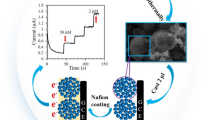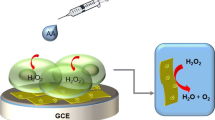Abstract
As an important detection technology, how to realize the rapid detection of H2O2 is very important for the early diagnosis of some diseases. Herein, octahedral porous carbon composites containing Cu and MoO2 are prepared by using bimetallic metal–organic frame (MOF) NENU-5 as precursor. It is found that Cu and MoO2 nanoparticles of Cu-MoO2-C are uniformly dispersed in the porous carbon framework. For the electrochemical detection of H2O2, compared with the Cu-C composite without MoO2, Cu-MoO2-C shows stronger redox ability, higher sensitivity (121 μA mM−1 cm−2), and lower detection limit (95.5 nM). In addition, Cu-MoO2-C also shows strong anti-interference ability and H2O2 detection sensitivity in the presence of a variety of interference substances. Our work proves that MoO2 has a good H2O2 reduction ability, and it also proves that the H2O2 detection performance of the sensors can be improved by using the constructed metal–metal oxide-porous frame materials.




Similar content being viewed by others
References
Dickinson BC, Chang CJ (2011) Chemistry and biology of reactive oxygen species in signaling or stress responses. Nat Chem Biol 7:504–511
Wang R, Peng L, Zhao J, Zhang L, Guo C, Zheng W, Chen H (2015) Gardenamide A protects RGC-5 cells from H2O2-induced oxidative stress insults by activating PI3K/Akt/eNOS signaling pathway. Int J Mol Sci 16:22350–22367
Ochoa CD, Wu RF, Terada LS (2018) ROS signaling and ER stress in cardiovascular disease. Mol Aspects Med 63:18–29
Samadi Pakchin P, Ghanbari H, Saber R, Omidi Y (2018) Electrochemical immunosensor based on chitosan-gold nanoparticle/carbon nanotube as a platform and lactate oxidase as a label for detection of CA125 oncomarker. Biosens Bioelectron 122:68–74
Liang H, Xu M, Zhu Y, Wang L, Xie Y, Song Y, Wang L (2020) H2O2 ratiometric electrochemical sensors based on nanospheres derived from ferrocence-modified covalent organic frameworks. ACS Applied Nano Materials 3:555–562
Maduraiveeran G, Sasidharan M, Ganesan V (2018) Electrochemical sensor and biosensor platforms based on advanced nanomaterials for biological and biomedical applications. Biosens Bioelectron 103:113–129
Lee J-H, Mirzaei A, Kim J-Y, Kim J-H, Kim HW, Kim SS (2020) Optimization of the surface coverage of metal nanoparticles on nanowires gas sensors to achieve the optimal sensing performance. Sens Actuators B 302:127196
Zhou J, Zhao Y, Bao J, Huo D, Fa H, Shen X, Hou C (2017) One-step electrodeposition of Au-Pt bimetallic nanoparticles on MoS2 nanoflowers for hydrogen peroxide enzyme-free electrochemical sensor. Electrochim Acta 250:152–158
Liu T, Guo Y, Zhang Z, Miao Z, Zhang X, Su Z (2019) Fabrication of hollow CuO/PANI hybrid nanofibers for non-enzymatic electrochemical detection of H2O2 and glucose. Sens Actuators, B Chem 286:370–376
Zhang Y, Wu M, Kwok YH, Wang Y, Zhao W, Zhao X, Huang H, Leung DYC (2019) In-situ synthesis of heterojunction TiO2/MnO2 nanostructure with excellent performance in vacuum ultraviolet photocatalytic oxidation of toluene. Appl Catal Environ 259:118034
Zhao Y, Huo D, Bao J, Yang M, Chen M, Hou J, Fa H, Hou C (2017) Biosensor based on 3D graphene-supported Fe3O4 quantum dots as biomimetic enzyme for in situ detection of H2O2 released from living cells. Sens Actuators, B Chem 244:1037–1044
Furukawa H, Cordova KE, O’Keeffe M, Yaghi OM (2013) The chemistry and applications of metal-organic frameworks. Science 341:1230444
Li B, Wen H-M, Cui Y, Zhou W, Qian G, Chen B (2016) Emerging Multifunctional Metal-Organic Framework Materials. Adv Mater 28:8819–8860
Kornienko N, Zhao Y, Kley CS, Zhu C, Kim D, Lin S, Chang CJ, Yaghi OM, Yang P (2015) Metal–organic frameworks for electrocatalytic reduction of carbon dioxide. J Am Chem Soc 137:14129–14135
Wang C, deKrafft KE, Lin W (2012) Pt Nanoparticles@Photoactive metal–organic frameworks: efficient hydrogen evolution via synergistic photoexcitation and electron injection. J Am Chem Soc 134:7211–7214
Xu H-Q, Hu J, Wang D, Li Z, Zhang Q, Luo Y, Yu S-H, Jiang H-L (2015) Visible-light photoreduction of CO2 in a metal–organic framework: boosting electron–hole separation via electron trap states. J Am Chem Soc 137:13440–13443
Nohra B, El Moll H, Rodriguez Albelo LM, Mialane P, Marrot J, Mellot-Draznieks C, O’Keeffe M, Ngo Biboum R, Lemaire J, Keita B, Nadjo L, Dolbecq A (2011) polyoxometalate-based metal organic frameworks (POMOFs): structural trends, energetics, and high electrocatalytic efficiency for hydrogen evolution reaction. J Am Chem Soc 133:13363–13374
Manna P, Debgupta J, Bose S, Das SK (2016) A Mononuclear CoII coordination complex locked in a confined space and acting as an electrochemical water-oxidation catalyst: a “ship-in-a-bottle” approach. Angew Chem Int Ed 55:2425–2430
Wu HB, Xia BY, Yu L, Yu X-Y, Lou XW (2015) Porous molybdenum carbide nano-octahedrons synthesized via confined carburization in metal-organic frameworks for efficient hydrogen production. Nat Commun 6:6512
Manoj D, Saravanan R, Santhanalakshmi J, Agarwal S, Gupta VK, Boukherroub R (2018) Towards green synthesis of monodisperse Cu nanoparticles: An efficient and high sensitive electrochemical nitrite sensor. Sens Actuators, B Chem 266:873–882
Gawande MB, Goswami A, Felpin F-X, Asefa T, Huang X, Silva R, Zou X, Zboril R, Varma RS (2016) Cu and Cu-Based Nanoparticles: synthesis and Applications in Catalysis. Chem Rev 116:3722–3811
Fazio E, Spadaro S, Bonsignore M, Lavanya N, Sekar C, Leonardi SG, Neri G, Neri F (2018) Molybdenum oxide nanoparticles for the sensitive and selective detection of dopamine. J Electroanal Chem 814:91–96
Tavakkoli N, Soltani N, Sadeghi M, Salavati H (2019) Electrochemical determination of methimazole using nanoporous gold film electrode modified with MoO2 thin film. Microchem J 150:104153
Dong Y, Zhou M, Zhang L (2019) 3D multiporous Co, N co-doped MoO2/MoC nanorods hybrids as improved electrode materials for highly sensitive simultaneous determination of acetaminophen and 4-aminophenol. Electrochim Acta 302:56–64
Qi X, Tian H, Dang X, Fan Y, Zhang Y, Zhao H (2019) A bimetallic Co/Mn metal– organic-framework with a synergistic catalytic effect as peroxidase for the colorimetric detection of H2O2. Anal Methods 11:1111–1124
Lin K-S, Adhikari AK, Ku C-N, Chiang C-L, Kuo H (2012) Synthesis and characterization of porous HKUST-1 metal organic frameworks for hydrogen storage. Int J Hydrogen Energy 37:13865–13871
Xiong K, Zhou G, Zhang H, Shen Y, Zhang X, Zhang Y, Li J (2018) Bridging Mo2C–C and highly dispersed copper by incorporating N-functional groups to greatly enhance the catalytic activity and durability for carbon dioxide hydrogenation. J Mater Chem A 6:15510–15516
Bao S, Luo S-H, Yan S-X, Wang Z-Y, Wang Q, Feng J, Wang Y-L, Yi T-F (2019) Nano-sized MoO2 spheres interspersed three-dimensional porous carbon composite as advanced anode for reversible sodium/potassium ion storage. Electrochim Acta 307:293–301
Zhang L, He W, Ling M, Shen K, Liu Y, Guo S (2018) Cu@MoO2@C nanocomposite with stable yolk-shell structure for high performance lithium-ion batteries. J Alloy Compd 768:714–721
Asif M, Aziz A, Wang HT, Wang ZY, Wang W, Ajmal M, Xiao F, Chen XD, Liu HF (2019) Superlattice stacking by hybridizing layered double hydroxide nanosheets with layers of reduced graphene oxide for electrochemical simultaneous determination of dopamine, uric acid and ascorbic acid. Microchim Acta 186:61–71
Li B, Liu LH, Zhang XF, Gao Y, Deng ZP, Huo LH, Gao S (2021) Echinus-like Cu–Mo2C/C yolk-shell composites for ultrasensitive detection of hydrogen peroxide. Electrochim Acta 373:137908
Mani V, Selvaraj S, Peng TK, Lin HY, Jeromiyas N, Ikeda H, Hayakawa Y, Ponnusamy S, Muthamizhchelvan C, Huang ST (2019) ZnCo2O4 nanoflowers grown on Co3O4 nanowire-decorated Cu foams for in situ profiling of H2O2 in live cells and biological media. ACS Appl Nano Mater 2:5049–5060
Asif M, Haitao W, Shuang D, Aziz A, Zhang G, Xiao F, Liu H (2017) Metal oxide intercalated layered double hydroxide nanosphere: with enhanced electrocatalyic activity towards H2O2 for biological applications. Sens Actuators, B Chem 239:243–252
Juang F-R, Chern W-C (2019) Controlled synthesis of cuprous oxide nanoparticles with different morphologies for nonenzymatic hydrogen peroxide sensing applications. J Electrochem Soc 166:B200–B204
Qi C, Zheng J (2016) Novel nonenzymatic hydrogen peroxide sensor based on Ag/Cu2O nanocomposites. Electroanalysis 28:477–483
Li Y, Zhong Y, Zhang Y, Weng W, Li S (2015) Carbon quantum dots/octahedral Cu2O nanocomposites for non-enzymatic glucose and hydrogen peroxide amperometric sensor. Sens Actuators, B Chem 206:735–743
Jiang B-B, Wei X-W, Wu F-H, Wu K-L, Chen L, Yuan G-Z, Dong C, Ye Y (2014) A non-enzymatic hydrogen peroxide sensor based on a glassy carbon electrode modified with cuprous oxide and nitrogen-doped graphene in a nafion matrix. Microchim Acta 181:1463–1470
Saha B, Jana SK, Majumder S, Satpati B, Banerjee S (2015) Selective Growth of co-electrodeposited Mn2O3-Au spherical composite network towards enhanced non-enzymatic hydrogen peroxide sensing. Electrochim Acta 174:853–863
Hao C, Shen Y, Wang Z, Wang X, Feng F, Ge C, Zhao Y, Wang K (2016) Preparation and characterization of Fe2O3 nanoparticles by solid-phase method and its hydrogen peroxide sensing properties. ACS Sustainable Chem Eng 4:1069–1077
Zhang N, Zheng J (2017) Synthesis of Ag–Fe2O3–RGO nanocomposites for the electrocatalytic reduction of H2O2. J Mater Sci: Mater Electron 28:11209–11216
Author information
Authors and Affiliations
Corresponding author
Additional information
Publisher's note
Springer Nature remains neutral with regard to jurisdictional claims in published maps and institutional affiliations.
Supplementary Information
Below is the link to the electronic supplementary material.
Rights and permissions
About this article
Cite this article
Xu, L., Xin, Y., Ma, Y. et al. Copper and molybdenum dioxide co-doped octahedral porous carbon framework for high sensitivity electrochemical detection of hydrogen peroxide. Ionics 28, 919–925 (2022). https://doi.org/10.1007/s11581-021-04294-5
Received:
Accepted:
Published:
Issue Date:
DOI: https://doi.org/10.1007/s11581-021-04294-5




